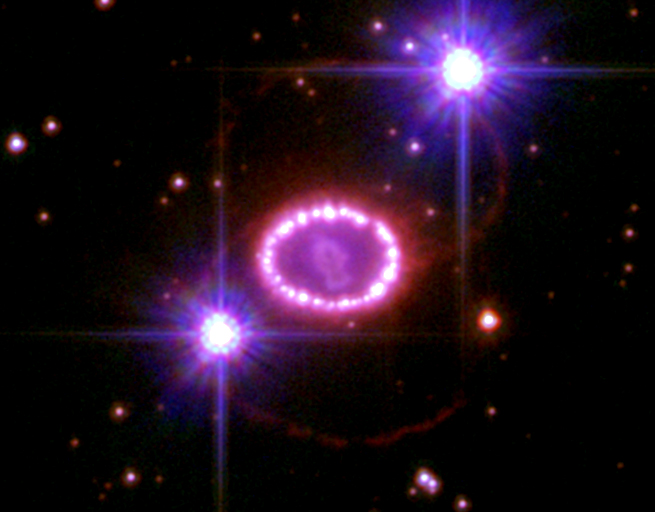 |
| By NASA, ESA, P. Challis, and R. Kirshner (Harvard-Smithsonian Center for Astrophysics) - http://hubblesite.org/newscenter/archive/releases/2007/10/image/a/ (direct link), Public Domain, https://commons.wikimedia.org/w/index.php?curid=1948789 |
Supernovas
A supernova happens when is a star at the end of its life. All of its matter rushes into its centre and becomes so compact that it either becomes a neutron star or black hole. The matter rebounds and a supernova occurs.
Type Ia supernova
A type Ia supernova happens when a white dwarf accretes matter from its binary companion. The white dwarf cannot go beyond 1.44 solar masses without reigniting itself due to the high pressures. In some cases, this causes a supernova.
Type Ib supernova
A type Ib supernova occurs when an extremely massive star collapses under its own gravity. Due to its massive size, it has fused hydrogen all the way to iron in a layered process. The star undergoing type Ib supernova would have lost its hydrogen layer earlier on. The star would either turn into a neutron star or black hole after undergoing supernova, or totally destroy itself.
Type Ic supernova
A type Ic supernova is similar to a type Ib supernova, but it sheds both its hydrogen and helium layers.
Type II supernova
A type II supernova occurs when a massive star rapidly collapses. Unlike type Ib and Ic supernovae, hydrogen is present.
Neutron stars
Neutron stars are made up of the collapsed core of a massive star. Its density is so high that the whole of Mt. Everest could fit in a sup of coffee. A neutron star is so compact that its radius is only 10 kilometres. Due to the intense pressures, protons and electrons fuse into neutrons.
Pulsars
Pulsars are extremely dense and compact stars that emits beams of electromagnetic radiation from its magnetic pole. It can either be a neutron star or a white dwarf. They rotate rapidly.
Over time, a neutron star slows down its rotation rate due to the emittance of electromagnetic energy. A neutron star's rotation speed can increase by absorbing orbiting matter from companion stars.
History
The first official neutron star was discovered by Jocelyn Bell. Neutron stars were first theorised by Walter Baade and Fritz Zwicky.
Black holes
Black holes are the collapsed core of massive star and is inescapable.
Its accretion disk is a mass of matter orbiting its black hole. It can be observed by radio telescopes.
Its event horizon is the point of no return. Once something goes past that point, it is not coming out.
The singularity is the point in the black hole where its mass is contained.
R e f l e c t i o n
Today, I learnt about supernovas, the processes that precede them and their results. I also learnt about their types and what causes them. I also learnt about neutron stars and black holes, which are ultra-dense objects. In my opinion, the presentation was good. It was filled with information and the presentation wasn't that content-heavy. The slides were ok and contained a decent amount of images and not too much text. The presentation could be improved by choosing a better colour scheme that contrasts with the background. It is difficult to see the blue words imposed on a black background as they did not contrast that much. It could also be improved by making it more concise as there was too much information in one space. I feel ok and I would like to learn more about the formation of stars.
Comments
Post a Comment